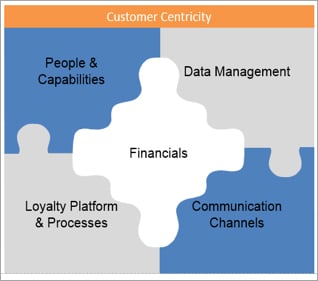Executing a Loyalty Program Checkup is not just about updating the Program Design – A Plea for Considering the Internal Hygiene Factors of a Loyalty Program.
“Market factors” are customer facing and influence the customer value proposition. There is no doubt that companies need to realign their loyalty approach and program design continuously, in order to keep up with the changes of consumers and loyalty landscape. It is also key to avoid complicated program structures and mechanics, large amount of time to redeem rewards and the lack of varieties or restrictive terms and conditions, to mention a few. However, having seen existing loyalty programs in different industries and experiencing their successes as well as their struggles, I can say that most companies wanting to improve their program put their main focus on updating their program structure and value proposition instead of first analyzing and optimizing the internal program setup and execution. This priority may lead to an investment which does not deliver the desired financial return.
By Nicole Wilhelm
#1 Financials
All loyalty marketers know and have experienced the burden of having to prove that loyalty programs and their initiatives have a positive impact on the ROI and are not just a cost factor. Therefore, it’s crucial to align on program KPIs, metrics and key success factors, as they are the key to proving the success of the program. Further, marketers need to be able to measure the effect of each loyalty campaign and activity and to gain flexibility through measurement on the cost side as well. For example campaign response measures to identify high performing campaigns or redemption metrics. The set-up of a constant reporting system allows the marketer to identify cost-saving potential as well as to react quickly to changes.
Additionally, being able to access the respective financial data, as well as having a common understanding of the budget planning process, results in a less vulnerable loyalty program. Too often, senior management seeks fast short-term results, whereas it is important to remember that setting up loyalty can take time.
A dedicated loyalty budget is one of the elements which allows the loyalty team to execute and develop the program and all loyalty initiatives to its best. Having experienced the opposite, with decisions leading to negative program performance or even worse, resulting in a program execution “just ticking over,” I am a strong supporter of loyalty programs with an independent budget.
#2 People & Capabilities
For customer-facing industries, your frontline employees make the difference. Every point of contact between an employee and customer is the opportunity to positively influence the member’s experience. It is your employees who generate positive emotions with program members, but in most companies, there is room for improvement. Research shows that only 21% of members are prompted by brand representatives to use the program, only 20 % get help to make the most out of their membership and only 19% feel special and recognized by brand representatives.
Make your staff your best advocates because they represent both the brand and your program. They need to be provided with all the necessary trainings, information and participation. There is nothing better than having an employee participating in your loyalty program and knowing it inside out. Reports show that when representatives make members feel positive emotions, there is a higher likelihood of member retention. These are critical competitive advantages.
Make sure to provide back-office people with the right capabilities in order to manage and develop a program successfully. You need experts in the different loyalty functions such as program strategy, design & execution, marketing automation & campaign management, analytics & segmentation, and the loyalty platform.
#3 Loyalty Platform & Processes
Customer loyalty ventures often start off as basic loyalty programs containing an earn-burn-structure and possibly other beneficial elements. In most cases, the implemented loyalty platform is either developed in-house, or an external loyalty solution is being used. Whichever solution is implemented, it is crucial that there is an alignment with the necessary company IT infrastructure and objectives in order to allow best program usage and the program growth.
Companies need to understand that there is the strong need to invest in the right technology as loyalty initiatives are not isolated from the overall technology strategy of the company. A companywide loyalty approach guarantees involvement and support of your technology stakeholders.
Further, I often experience that the definition of business processes is underestimated and neglected when implementing a loyalty program. This can result in complex and frustrating customer processes; e.g., for program sign up or point redemption which can lead to lower activity and, even worse, a negative customer experience. At the same time, the missing of process definitions leads to internal miscommunication, or lack of information and understanding, especially with your frontline staff e.g. claims handling. Getting your processes right and defined is another low hanging fruit that can have a huge impact on program performance.
#4: Data Management
Your customer data tells the story and is the foundation for the continuous successful management and development of your customer loyalty program. One might say it is the reason marketers are operating loyalty programs.
Those programs leveraging information to build lasting customer relationships through relevant communications, rewards, and other personalized perks will win the race for customer loyalty. Since the launch of each program, customer habits and expectations might have changed. It is a company’s challenge to continue engaging these customers. Your consumer data will stay on top of these trends and allow you to use this knowledge to adapt program design accordingly. Marketers who develop a holistic, 360 degree, analytical view of customer relationships by linking data from loyalty, CRM, web, social, and mobile channels are seeing the full customer picture.
But there is more to data than getting to know your customer. A successful loyalty strategy consists of the right set of metrics based on the overall business objectives. As already mentioned, marketers often struggle internally to isolate the impact of their loyalty efforts, but, on the other hand, need to prove effectiveness. Therefore, it is crucial to keep measurement at the forefront to ensure that all your loyalty initiatives can be effectively measured and you have efficient and complete data access.
Companywide data access also encourages other departments, e.g. sales or product development, to use the available customer data in their daily business. This has another charming aspect as it improves the reputation of the program from being a sole cost factor toward a profitable marketing asset.
#5 Communication Channels
Integration and alignment of loyalty and marketing initiatives is necessary in order to deliver a relevant and consistent customer experience. There are too many examples where customers receive two emails a day from the same company because they signed up to the regular email list and because they are members of the loyalty program. A successful omni-channel loyalty program will connect customers to a brand across all touchpoints with the right content at the right time. Research shows that 95% of members want to engage with their program through new and emerging technology (e.g.wearables, chatbots).
In order to prove the effectiveness of your communication and loyalty initiatives, automated measurement is important. It saves a lot of internal resources and time having to prove the actual contribution of each activity if the objectives and KPIs are defined in advance and the current data is available and accessible.
Integrated communication also includes internal communication. Knowing that especially in the retail and service industry, frontline staff (e.g. sales staff and call center) deliver the brand and customer experience, it is important to involve these employees early and on an ongoing basis. They are the first to get feedback from your customers; therefore, they need to be heard and valued. It is too often that this valuable input is not being recorded and used for future development and changes.
Aligning all five factors with each other guarantees a customer centric approach and culture within the company Customer centricity means taking customer loyalty seriously and executing loyalty companywide. Loyalty cannot be seen as a silo initiative: It is as important to secure executive commitment as well as alignment with all relevant departments in order to leverage loyalty across the entire company. Loyalty needs to be a corporate initiative where everyone is held accountable for its success.
 Figure 2: Hygiene Factors
Figure 2: Hygiene Factors
Key Takeaways
- Marketers responsible for a loyalty program mostly struggle with
- Underperforming loyalty programs that need to deliver results
- Undefined program objectives and unclear program performance
- A program that is internally on the watch or seen as a cost factor only
- On top, they encounter the following program challenges
- Battle against program stagnation and member fatigue
- Need for growth and development with the changing loyalty landscape
- Analysis and resolution of missed opportunities when program was launched
- To counter these issues, a program health check is necessary to setup the program for success
- Avoid focusing on market factors (program value proposition) only when restructuring the program as this can result in larger financial long-term investment
- Consider to check hygiene factors (program execution and customer experience) which are often failed during implementation.
- Companies and marketers should not miss this opportunity for low hanging fruits when redesigning their program.
Sources
Bond Brand Loyalty Report 2018
Bond Brand Loyalty, Common Pitfalls of Loyalty Program Design
eMarketer, Research June 2017
Forrester, Vendor Landscape: Customer Loyalty Solutions
Loyalty Management Magazine Summer 2017
Maritz Motivation Solutions, The 4D Loyalty Framework
Maritz and Wise Marketer Loyalty Landscape, Report 2018
 Nicole is a Customer Loyalty Expert in the area of Loyalty Programs, Campaign Management, Customer Insights, and supporting IT solutions. Through the years, Nicole worked with companies such as Lufthansa Miles & More, American Express, and Arvato Bertelsmann. Her clients use her expertise for design or redesign of loyalty programs, management and fulfillment of marketing initiatives, and evaluation and implementation of necessary IT solutions. Following three years of successful loyalty engagements in the US, Nicole will be returning in 2018 to Germany to focus on her independent consultancy, get-focused.com.
Nicole is a Customer Loyalty Expert in the area of Loyalty Programs, Campaign Management, Customer Insights, and supporting IT solutions. Through the years, Nicole worked with companies such as Lufthansa Miles & More, American Express, and Arvato Bertelsmann. Her clients use her expertise for design or redesign of loyalty programs, management and fulfillment of marketing initiatives, and evaluation and implementation of necessary IT solutions. Following three years of successful loyalty engagements in the US, Nicole will be returning in 2018 to Germany to focus on her independent consultancy, get-focused.com.
Nicole Wilhelm is a Certified Loyalty Marketing Professional (CLMP). She can be reached




